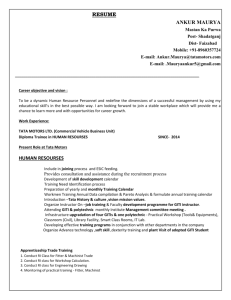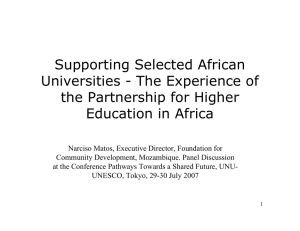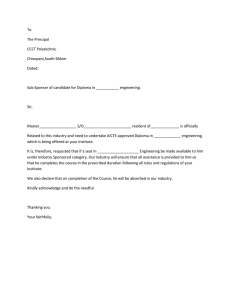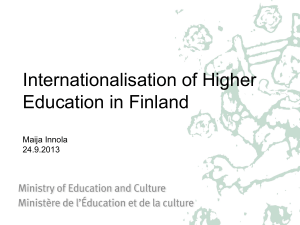Details of the Scheme
advertisement
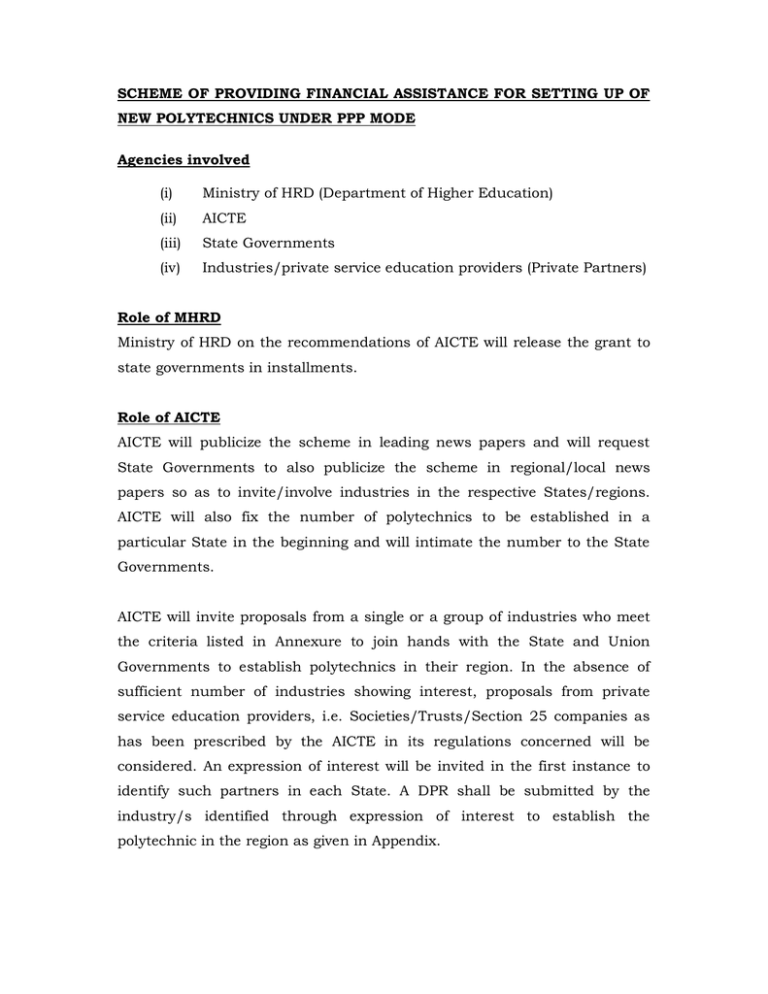
SCHEME OF PROVIDING FINANCIAL ASSISTANCE FOR SETTING UP OF NEW POLYTECHNICS UNDER PPP MODE Agencies involved (i) Ministry of HRD (Department of Higher Education) (ii) AICTE (iii) State Governments (iv) Industries/private service education providers (Private Partners) Role of MHRD Ministry of HRD on the recommendations of AICTE will release the grant to state governments in installments. Role of AICTE AICTE will publicize the scheme in leading news papers and will request State Governments to also publicize the scheme in regional/local news papers so as to invite/involve industries in the respective States/regions. AICTE will also fix the number of polytechnics to be established in a particular State in the beginning and will intimate the number to the State Governments. AICTE will invite proposals from a single or a group of industries who meet the criteria listed in Annexure to join hands with the State and Union Governments to establish polytechnics in their region. In the absence of sufficient number of industries showing interest, proposals from private service education providers, i.e. Societies/Trusts/Section 25 companies as has been prescribed by the AICTE in its regulations concerned will be considered. An expression of interest will be invited in the first instance to identify such partners in each State. A DPR shall be submitted by the industry/s identified through expression of interest to establish the polytechnic in the region as given in Appendix. After selection of the polytechnics/location of the polytechnics and receipt of proposals from the State Government along with MOUs with private partners, AICTE will sent a consolidated proposals of the States to the Ministry of Human Resource Development for release of grant. Role of the State Government State Governments will give vide publicity of the scheme in the local/regional newspapers so as to involve industries for setting up of polytechnics. On receipt of the information about the maximum number of polytechnics to be set up in the state under this scheme, State Government will send proposals to AICTE so that AICTE may suitably select the polytechnics following the criteria for that state. The State Government along with AICTE will finalize the list of polytechnics to be established and will sign MOU with the private partners and the AICTE as per the prescribed MOU. Role of an Industry Partner (i) The Partner should be a company of repute with good governance. (ii) The Partners should actively participate in the Governance of the institute within the overall framework. For membership in the Board of Governors they should propose the nomination of senior officials to the Nominations Committee so that there is active participation. (iii) The Partner should be willing to do joint projects with polytechnics either through funding collaboration or in any other manner. (iv) The Partner should be willing to depute very accomplished individuals as adjunct faculty or otherwise participate in the teaching activities of the polytechnics. (v) The Partner should be willing to allow students to do project works as a part of their course, within their enterprise. They must also provide mentors for developing the students in such projects. (vi) The Partner should be willing to allow training to the faculty of the polytechnics so that there is greater interaction. (vii) The Partner should have the willingness and ability to co-create Programs with the polytechnics. (viii) The Partner should allow internship for students from the polytechnics. (ix) The Partners should facilitate for placement of the students from the polytechnics. (x) The Partner should be willing to join and help fund the startup of the institution making a contribution of a minimum of Rs. 10 crore or as decided by the State and Union Government. (xi) The Partner should be eligible for a full deduction of their contribution against their income under the income Tax Act as is currently allowed for any grants made to Universities in India under S10(22) of the Income Tax Act 1961. A notification of an amendment is essential in the law for this purpose. Deliverables Constitution of Institute Management Committee (IMC) The Institute Management Committee will consist of:1. The Chairperson to be nominated by the Industry. 2. Two persons to be nominated by the Government of the State in which the Institute is situated. 3. Four persons having special knowledge or practical experience in respect of education, engineering or science including the IT Industry, to be nominated by the participating industry/industries. 4. One Head of section on rotation of the polytechnics to be nominated by the IMC 5. One nominee of the Ministry in the Central Government dealing with Technical Education/ AICTE. 6. One person to be nominated by the CII. 7. One eminent person having knowledge and experience from civil society to be nominated by the IMC (Panchayat/Collector). 8. The Director/Principal - ex-officio Member- Secretary. Land The Industry may provide land in the industry’s campus separately for setting up of the institute as per the requirement of the AICTE. The land deeds are to be transferred to the Institute Management Committee. Alternatively, the State will provide land for setting up of new polytechnic. Funds Rs.3.00 crore will be provided by Ministry of Human Resource Development to the State Governments in installments on the recommendations of the AICTE. Rs.2.00 crore will be provided by the State Govt. and in case land is provided by the State Govt., the condition of Rs.2.00 crore can be waived of. A minimum of Rs.10.00 crores will be deposited by the private partner for construction of building, equipment and running of the polytechnic in IMC account. Building & Equipment The building is to be constructed by the IMC and will meet all the expenditure on purchase of equipment, development of land etc. through the funds deposited in the IMC account. Recurring Expenditure Recurring expenditure is to be borne by the IMC through fees, internal revenue generation etc. Private partners will meet additional requirement of capital and recurring expenditure, if required. Admissions Admissions will be made by the State Governments based on the admission procedure being followed in the State. However, it will have to be ensured through the MOU that the access to the weaker and disadvantaged sections is facilitated through concessional fees/scholarship and other such affirmative action. Fees Fees for all the polytechnics under PPP mode will be decided by the State Govt. in consultation with the representative of IMC. Programs to be officered Programs to be started in the polytechnics will be decided by the IMC and shall relate to the industry which is partnering under this project and in case the private partner is not industry then the State Govt. will identify the need in the region and accordingly decide Programs to be started in consultation with the IMC. Teaching faculty AICTE norms will be followed for teaching faculty of a diploma institution. However, adjunct faculty from the industry concerned shall be encouraged. Affiliation To begin with the polytechnics may be affiliated to the respective Boards of Technical Education of the state as in case of others polytechnics. Thereafter, these polytechnics (only in case of Industry partners) may be awarded Autonomous status (Academic Autonomy only) by the state governments in consultation with AICTE or as per the procedure prescribed for the purpose by AICTE so as to bring theses polytechnics as national level polytechnics. Annexure CRITERIA FOR SELECTING INDUSTRY PARTNERS FOR SETTING UP POLYTECHNICS IN PPP MODE CRITERIA FOR INDUSTRY PARTNERS SELECTION 1. There should be single or multiple industry partners under this scheme to join together with Government to set up polytechnics. Multiple partners are preferred so that collaboration in different areas is possible. 2. The industry partners can be core companies and / or companies doing IT business. 3. Public sector industries could be actively encouraged to become partners. 4. The industry partners must be members of industry Association such as NASSCOM, FICCI, ASSOCHAM, CII etc so that adequate information is available in the public domain. 5. The Partner industry should normally have been in operations for at least 5 years. 6. The Partner industries should preferably as listed companies with a good governance and well regarded in the business community. Being listed implies that they are subject to regulatory control and information about them would be available in the public domain. 7. For those industries which are not listed they must have demonstrated track record, and good governance. 8. MNCs working in India with specialized knowledge and interest should also be encouraged to be partners. 9. The minimum contribution from an industry Partner should be Rs. 10 crore. Each partner may contribute different amounts to make up the required share. 10. The same company may fund different polytechnics based on their need. There should be no exclusive arrangements of any nature and the polytechnics should be free to work with multiple partners. 11. The industry Partners are eligible to seats on the Board of Governors (BOG) upto 60% of the total seats subject to their Nominees being eligible for appointment as per the criteria laid down. APPENDIX Detailed Project Report (DPR) to be submitted by the selected industries to the AICTE for the establishment of polytechnics in their region. 1. The need for a polytechnic in the region. a) Please describe whether the proposed polytechnic is being suggested to meet the current and future demands of the technician education in the region. Provide some back ground data on existing industries in the region. 2. The Setting a) Please describe technical education scenario in the state. b) Please provide information on number of students aspiring for education. c) Describe quality of education as obtained now (polytechnic education in the state). d) Provide information on curriculum and course developments in existing institution, how often they get updated. e) Describe Academia-Industry interaction as present now. f) Describe existing innovation ecosystem in the polytechnic education in the state incubator Programs, start up support. g) Describe the ongoing continuing education Programs in the academic institutions of the state. 3. The Justification a) List reasons for proposing polytechnics for strengthening technician education system. b) The strategies to make the institute self sustaining within five years. c) Describe how these polytechnics will positively impact other institutions in the state. 4. Location a) Give details on location (Land availability, climate, water availability in the campus, terrain, land cover etc.) b) What facilities are available within 10 and 20 kilometers from the location (schools, colleges, hospitals, shopping centres, hotels/restaurants, recreational facilities, public libraries, religious places) c) Is the land owned and in possession of the industry Government? d) How close is the location to an industrial cluster? How many industries are there in that cluster. e) Accessibility : nearest airport, railway station, bus stand the classification of the road leading to the location from these points (NH, SH, rural, arterial, major etc.) public transport availability (city bus service, train services etc) 5. Partners in the Consortium a) Give details on the partners (names – public/private, nature of business, listed/unlisted, turnover, evidence of interest in educational activities, around willing to contribute to corpus etc.) b) Apart from contributing to the corpus, do they plan to interact with the institution in more ways (recruitment, joint research, scholarships, awards, sponsored research, incubation, internship etc.) c) Would they want a say in the institute’s financial and academic governance? If yes, how. 6. Role of State Government a) Describe how the state government would continue its association with the institute. b) Apart from contributing to the corpus and providing land, does the state government plan to interact with the institution in more ways (recruitment, joint research, scholarship, awards, sponsored research, incubation, internship etc.) c) Would the government want a say in the institute’s financial and academic governance? If yes, how. 7. Academic Programs a) Please describe the academic Programs being planned for the first five years. b) How will the students for each Program be selected? (entrance tests policies regarding reservations, sons of the soil etc) c) Faculty recruitment policies d) Fee structure and the basis for fee fixation and fee revision e) Scholarships, sources, methods of awarding. 8. Educational Outreach Programs a) Will there be Programs for working professionals? If yes when will they be introduced? Nature of Programs (certificate, diploma etc), how will the students be selected and intake numbers. b) Will there be short term skill development Program for currently unemployed youth? If yes, details thereof. c) Do you plan to offer Programs in distance education mode? If yes, details. 9. Industry collaboration a) Your plans for industry collaboration 10. Governance Structure a) Legal form of the organization (registered society, registered charitable trust, sec 25 company, any other) and advantages of the chosen form. b) Who will the members of the general body in case of registered society, initial trustees in case of trust or share holders in case of sec 25 company. c) Governing board constitution and duration of the membership. d) Reconstitution of governing board and its bodies. e) Powers of the governing board. f) Principal: method of selection, duration of appointment and powers. g) Academic bodies (Senate board of studies and other committees) how will they be constituted and powers and responsibility. h) Applicability of RTI act. 11. Financial Model a) Capital expenditure (buildings including hostels, estate development, laboratory equipment and other infrastructure power, water and communication) year by year for next ten years. b) Operating expenditure (faculty/staff salaries, perks, academic expenses (library, lab material, etc.) power, water, infrastructure maintenance) year wise for next ten years. c) Sources and amount of income year wise for ten years (i) Student fees (ii) Income from facilities (hostels, auditorium etc) (iii) Net income from outreach (iv) Income from sponsored research, consultancy (v) Income from innovation and enterprises (vi) Other incomes d) Break even analysis e) Cash flow for ten years, year by year f) Will the institution borrow money, if so when, how much and how will it repay. g) Corpus building: target corpus at the end of first, third, fifth and tenth year sources for corpus and how corpus will be invested/used. 12. SWOT analysis a) Please provide your perception of your (state’s) strengths, weaknesses, and the opportunities. Please classify your threats/risks in to destructive (if it happens the institute will collapse), disabling (some major setback, but institute can still run) and discomforting. Describe your preparedness to face destructive risks. b) Describe your vision for the institute and how will your strengths will achieve this vision. c) Describe a post ten year scenario 13. How will the institute contribute to India’s development? a) Envision institute’s impact on the technician education and the economic growth of the country. 14. Any other information you want to provide in support of your proposal.
